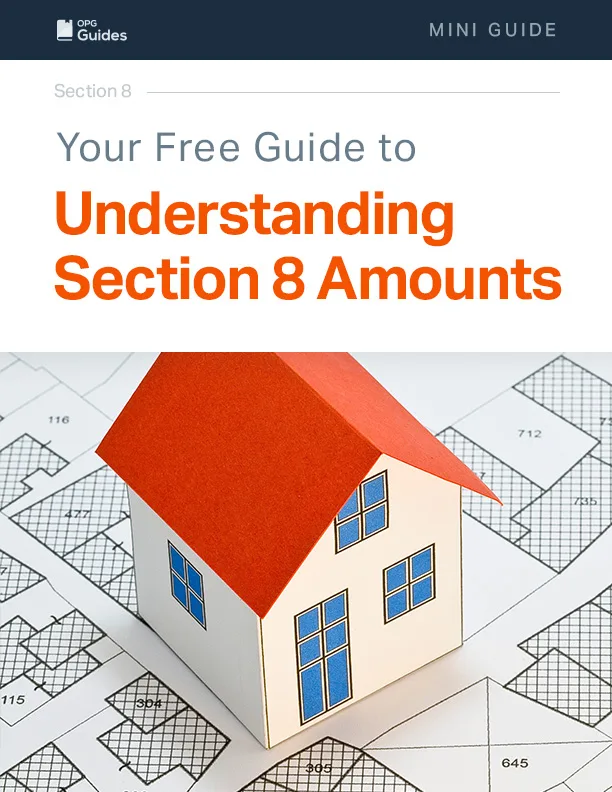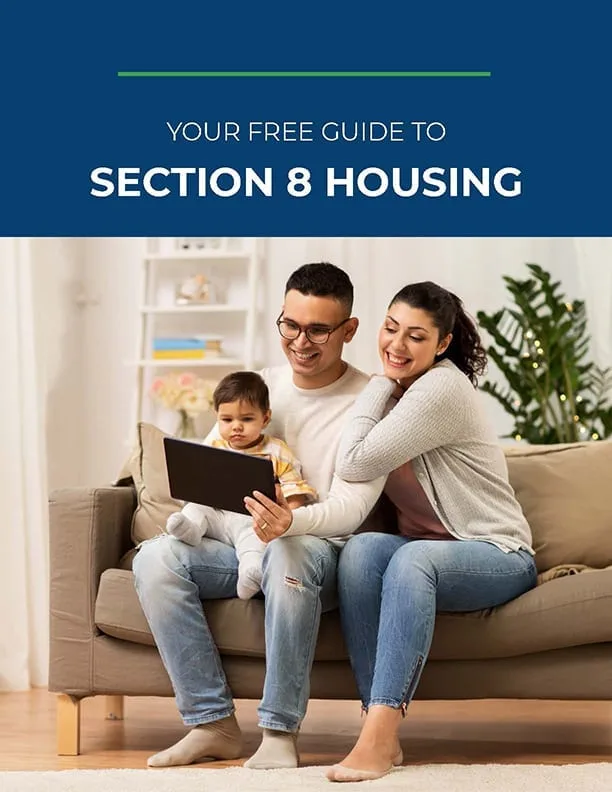Your Free Guide to the Section 8 Application Process
Your Free Guide to the Section 8 Application Process
We are privately owned and not affiliated with the government in any way or form.

Understanding Section 8
What is Section 8?
Section 8 is a federally funded housing assistance program designed to provide safe and affordable housing to low-income individuals and families. The program is officially known as the Housing Choice Voucher (HCV) program and is administered by the U.S. Department of Housing and Urban Development (HUD). Section 8 vouchers allow recipients to rent private market housing while paying only a portion of their income towards rent, with the rest being covered by the program.
Benefits of Section 8 Housing
Section 8 offers several benefits, including:
- Affordable Housing: Most participants pay around 30% of their income towards rent, making housing costs more manageable.
- Choice: Recipients can choose where they want to live, whether in an apartment, townhouse, or single-family home, as long as the landlord accepts Section 8 vouchers.
- Quality Standards: All housing units must meet HUD’s housing quality standards to ensure safe and habitable living conditions.
- Stability: The program provides stability and predictability in housing costs, allowing families to allocate resources to other essential needs.
Program Criteria
Each public housing agency (PHA) is responsible for determining the specific program requirements for the Section 8 program. However, there are a few requirements set by the Department of Housing and Urban Development (HUD) that apply in all PHAs. These are:
- Citizenship status: Only U.S. citizens and permanent nonresidents with eligible immigration status may participate in the Section 8 program.
- Social Security Number: At least one person in the family household must have a Social Security Number.
- Asset limitation: As of 2025, families may not have more than $103,200 in assets. This figure is subject to change each year to reflect changes in cost of living or inflation. Assets are defined as any items of value that a household owns. These may include the following:
- Money in a savings or checking account
- Equity in a home
- Stocks
- Bonds
- Money in a retirement account
- Actual cash value of life insurance policies
To qualify for Section 8, you must typically meet other eligibility criteria, including:
- Income Limits: Your household income must be below a certain threshold, often around 50% of the median income for your area.
- Rental History: A positive rental history, without recent evictions or issues, is typically required.
- Criminal Background Check: Certain criminal offenses may disqualify you from the program.
Preparing for the Application

Since Section 8 is administered locally, there is no national application for Section 8 housing vouchers. To apply to the program, you must apply through a PHA that has an open waitlist.
First, PHAs often have you start by filling out a preliminary application (also called a “pre-application”) with basic information like:
- Your address
- Family size
- Date and time of application
- Racial or ethnic designation of the head of household
- Estimate of annual income
This pre-application is typically used to determine your initial eligibility. After completing this step in the process, you may be placed on a waiting list or denied Section 8.
Gather Necessary Documents
Before applying, it can help to gather essential documents such as:
- Proof of Identity: Driver’s license, passport, or other government-issued ID.
- Proof of Income: Pay stubs, tax returns, or other documents that show your household income.
- Social Security Numbers: For all household members.
- Citizenship or Eligible Immigration Status: Documentation to verify your status.
- Rental History: Contact information for previous landlords.
- Criminal Background Check: Be prepared to disclose any relevant criminal history.
Check Local Waitlist Openings
Section 8 programs often have waiting lists due to high demand. Check with your local Public Housing Agency (PHA) to find out if their waitlist is open and accepting new applications. You can also search for PHAs online, as some of them post information about the waiting list on their websites.
Determine Household Income
Calculate your total household income, including wages, government assistance, and any other sources. This will help determine if you meet the income requirements for the program.
Where and How to Apply
The application process is managed by local PHAs. Locate your nearest PHA and inquire about the application process.
To find your local PHA, you can use the search tool or the interactive map provided by HUD here: https://www.hud.gov/program_offices/public_indian_housing/pha/contacts
You can usually apply online or in person, depending on the PHA. If you are placed on the waiting list, you’ll need to wait until you get to the top in order to choose a Section 8 unit.
Once your name is chosen from the list, the PHA will likely ask you to fill out a full application. Unlike the pre-application mentioned in the previous section, the full application will ask for more detailed information about your household.
Each PHA may have its own instructions for filling out a Section 8 application. However, there are several guidelines to follow no matter where you apply.
General Online Application Process
- Visit your PHA’s website and navigate to the Section 8 application page.
- Create an account if required, providing a valid email address and password.
- Fill out the application form as accurately as possible.
- Upload digital copies of required documents.
- Review and submit your application.
General In-Person Application Submission
- Visit your PHA’s office during business hours.
- Request a Section 8 application and any necessary forms.
- Complete the application neatly and truthfully.
- Attach copies of required documents.
- Submit the application to the designated staff.
Filling Out the Application

- Personal Information
Provide your name, date of birth, contact information, and Social Security number.
- Household Details
List all members of your household, including their names, dates of birth, and relationships to you.
- Preferences and Special Circumstances
Indicate any preferences you may have, such as specific neighborhoods or accessibility needs. Notify the PHA if you have any special circumstances that should be considered.
- Landlord Information
If you already have a prospective rental unit in mind, provide the landlord’s contact information.
Required Documents
In general, full applications usually ask for:
- Proof of Identity: Include a copy of a government-issued ID for all adult household members. This includes information about dependents, elderly family members, disabled family members, etc.
- Proof of Income: Submit documents that verify your household’s income, such as pay stubs, tax returns, or benefit award letters. Additionally, they may ask for a list of checking and savings accounts for all household members.
- Social Security Numbers: Provide valid social security numbers for all household members.
- Citizenship or Eligible Immigration Status: Include documentation that confirms your citizenship or eligible immigration status.
- Rental History: List previous rental addresses and landlord contact information for the past few years. Also include information about previous evictions from federally assisted housing.
- Criminal Background Check: Be honest about your criminal history if applicable, including information about any past drug- or alcohol-related arrests. Some offenses may not disqualify you, depending on their nature and recency.
Submitting Your Application
Online Submission Steps
Double-check that you have completed all required fields and attached the necessary documents before submitting your online application.
In-Person Submission Guidelines
When submitting your application in person, ensure that all forms are completed neatly and legibly. Confirm with the PHA staff that you have included all required documents.
After Submission
After you submit a Section 8 application, your family may:
- Receive a letter of denial.
- Be placed onto a waiting list.
- Receive a voucher right away, if funding is available.
Waitlist Confirmation
After submitting your application, you will receive confirmation of being placed on the waitlist. This may be through email or postal mail.
Waiting Period Expectations
Waitlist times can vary significantly. It’s essential to be patient, as wait times can be several months to several years.
Updating Application Information
If any changes occur while on the waitlist, such as changes in household composition or contact information, inform the PHA immediately to keep your application up to date.
Denied Application: The Appeals Process

Reasons for Denial
If your application is denied, you should receive a notification outlining the reason. Common reasons include:
- Not meeting the program’s eligibility criteria.
This could refer to area income limit, immigration status, college enrollment or any other requirement.
- A previous eviction from rent-assisted housing.
PHAs may deny Section 8 admission to a family if any member of the household was evicted from federally assisted housing within the last five years.
- Fraud, bribery or any other criminal act in relation to rent assistance.
PHAs are allowed to deny an application if a member of the family has committed any corrupt or criminal act in connection to a federal housing program. This includes submitting false information on the application.
- Having an outstanding balance with a PHA.
If a family member owes rent or has an outstanding balance with any PHA, the household’s application may be denied.
The decision to deny an application is generally made by the individual PHA to which you applied. PHAs may consider mitigating circumstances when deciding whether or not to approve or deny an application.
For example, if a family member was removed from the Section 8 program for abusing alcohol in the past, but has since completed a supervised rehabilitation program, the PHA may decide to approve a new application.
Requesting an Appeal
If you believe your application was wrongly denied, you can request an appeal. This usually involves submitting a written request explaining why you believe the decision was incorrect.
Informal Review
The PHA will generally assign someone to review its decision to deny the application. The reviewer cannot be the same person who made the denial decision in the first place. You will be given the opportunity to respond to the PHA’s decision with a spoken or written statement. In your statement, you can explain and give examples of why you believe the PHA’s decision is wrong.
After the informal review, the PHA must notify you of the final decision and briefly explain the decision.
Conclusion
Navigating the Section 8 application process requires careful attention to detail and adherence to guidelines. By understanding eligibility criteria, preparing necessary documents, and completing the application accurately, you may be able to increase your chances of securing this valuable housing assistance.
Remember that patience is key due to potential waitlists, and don’t hesitate to explore the appeals process if your application is denied unjustly. Through this process, individuals and families can access safe and affordable housing, improving their overall quality of life.






